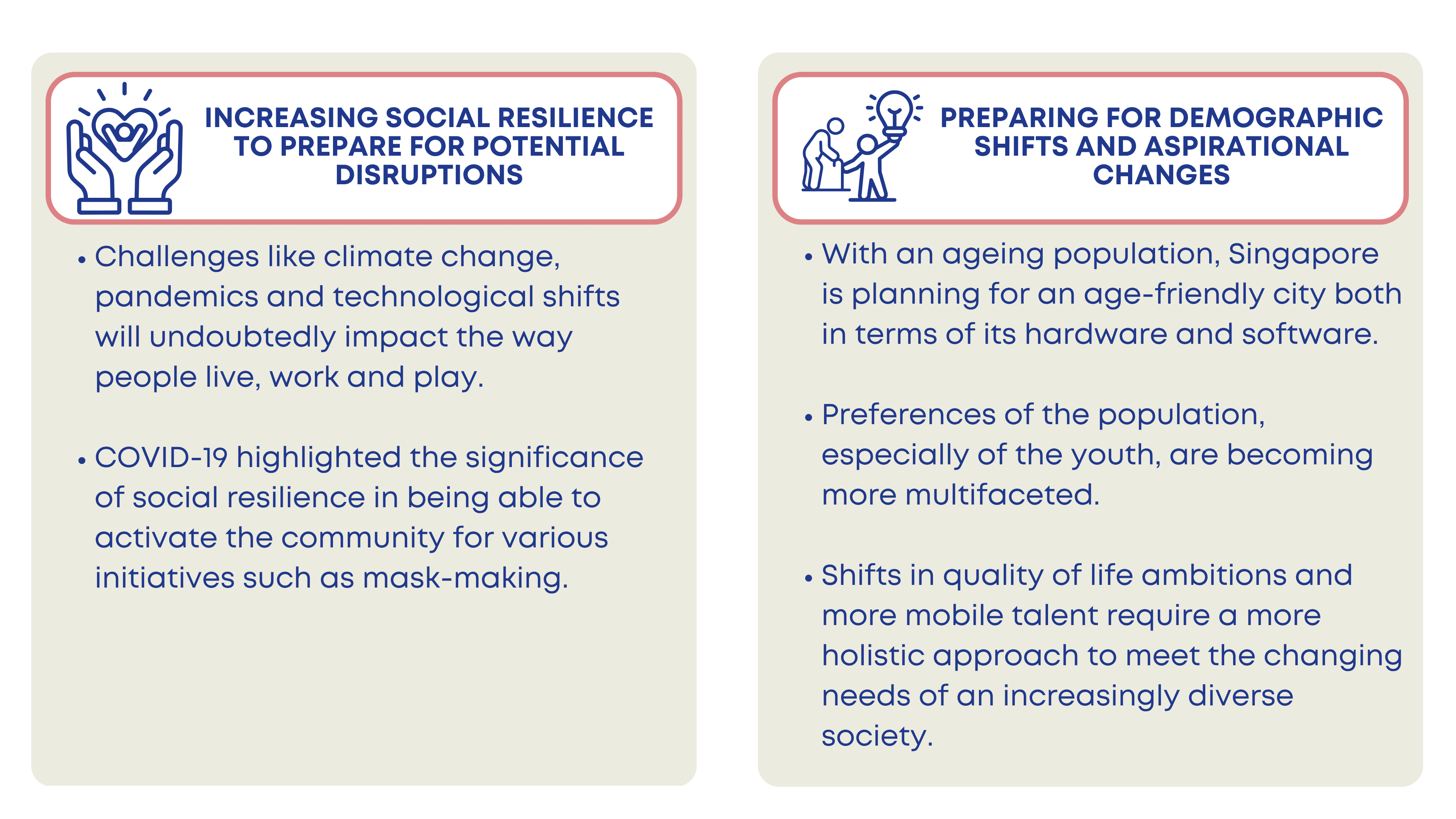High Quality of Life
Discover how Singapore accommodates evolving needs for individual and collective well-being to cultivate safe, vibrant and inclusive communities.
On this page

People relaxing at Bedok Reservoir Park (Unsplash)
A high quality of life is a vital liveability outcome to have alongside a competitive economy and a sustainable environment. For Singapore, it prompts the need to keep residents at the heart of everything that it does and is a reminder that the city cannot be developed at the expense of livelihoods and welfare.
Therefore, a high quality of life encompasses a balance of all the positive economic, social, environmental, emotional and physical aspects of urban living. Beyond essentials like safety, food, housing and healthcare, there is also a growing emphasis on inclusivity, social cohesion, well-being, mental health and purpose in life.
Contextual Considerations

Core Tenets of Quality of Life

Basic liveability standards such as housing must first be met to safeguard residents' wellbeing (Unsplash)
At the foundation of Maslow’s Hierarchy of Needs lies the basic survival needs which must be met before individuals can pursue higher aspirations such as belonging, self-esteem and fulfilment. Similarly, for a liveable city, the fundamental provisions for quality of life have to be in place. These are aspects of liveability that are crucial for keeping residents safe and healthy, and enable them to live comfortably.
Safety
Systems and institutions: Low crime rates are maintained through robust law enforcement, a strong justice system and public trust. Safety is viewed holistically, extending beyond crime prevention to include protection from both internal and external threats, including societal tensions and terrorism.
Urban heat island mitigation: Climate change is a disruption that will affect not just the health of the planet, but also the way residents experience the city. The urban heat island effect, amplified by Singapore's built density and global warming, creates challenging outdoor conditions that affect both public health and economic activities — from construction to tourism. Enhancing the built environment to tackle the intensifying effects of heat aims to reduce heat absorption, improve outdoor comfort and safeguard public health.
Affordability
Support for lower- to middle-income households: In 2025, the Singapore Budget included vouchers and rebates as well as funds for skills development and training for workers. Other support measures are focused on affordability, such as the Budget Meals initiative where participating coffee shops in the heartlands offer meals for S$3.50 or less.
Aspirations that Help to Elevate Quality of Life

A liveable city taps on its diverse population, creating social cohesion and allowing residents' to reach their full potential (Unsplash)
A mature city must go beyond basic provisions to provide for residents’ higher-order needs, building upon essential components of their quality of life. They often encompass the softer dimensions of a cosmopolitan lifestyle, which allow a city to thrive and contribute towards residents’ happiness, fulfilment and sense of belonging.
Thus, Singapore's liveability vision extends beyond traditional measures of success, embracing diverse pathways to achievement while ensuring social cohesion. Singapore also works to ensure no one is left behind, supporting citizens at every life stage while particularly focusing on providing early opportunities for lower-income families.
Inclusivity and Social Cohesion
Flexible and inclusive education: Multiple educational pathways are embraced through specialised education and career paths that allow students to take subjects based on their interests and capabilities, and by establishing specialised schools that focus on areas like arts and sports.
Forward Singapore exercise: A nationwide initiative aimed at refreshing the social compact, representing Singapore's commitment to building stronger social resilience for future challenges by harnessing the diversity of its population, harmonising different viewpoints and balancing varied needs.
Targeted support programmes: Lower-income families with children receive targeted and longer-term support through ComLink+, which helps prevent a permanent underclass and ensures children have full opportunities early in life. Through ComLink+, these families are connected with other programmes such as KidSTART, which equips parents with knowledge and skills to support the development of their children, from pregnancy until the child turns 6 years old.
Learn More about Singapore’s Efforts to Achieve a High Quality of Life:
Opinion: Urban Alchemy – Smiles Over Dollars in Placemaking Transformation
By Lorenzo Petrillo, Founder, LOPELAB
Opinion: Arts and Heritage – The Soul of a City with a Nation’s Heartbeat
By Rosa Daniel, Dean, Culture Academy
